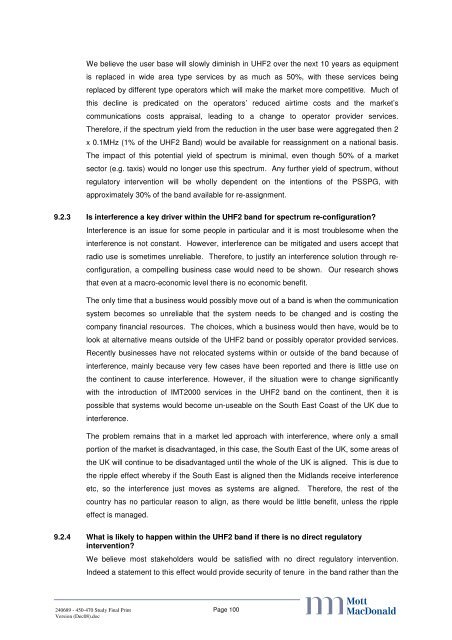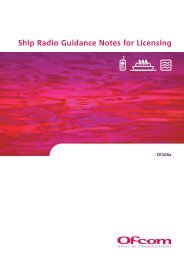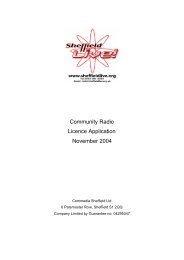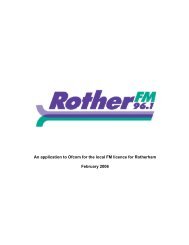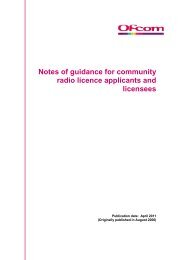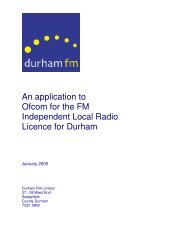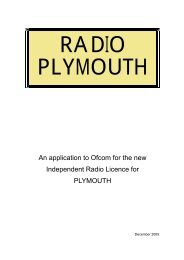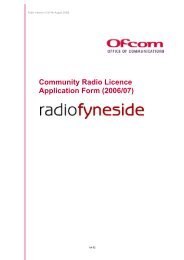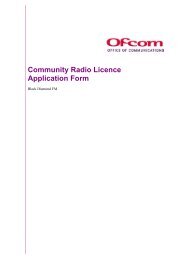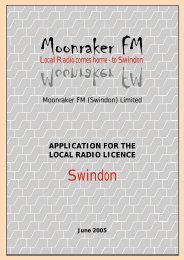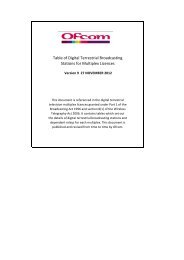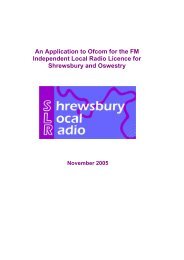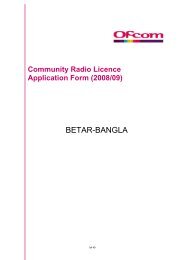UHF2 realignment study - Ofcom Licensing
UHF2 realignment study - Ofcom Licensing
UHF2 realignment study - Ofcom Licensing
Create successful ePaper yourself
Turn your PDF publications into a flip-book with our unique Google optimized e-Paper software.
We believe the user base will slowly diminish in <strong>UHF2</strong> over the next 10 years as equipment<br />
is replaced in wide area type services by as much as 50%, with these services being<br />
replaced by different type operators which will make the market more competitive. Much of<br />
this decline is predicated on the operators’ reduced airtime costs and the market’s<br />
communications costs appraisal, leading to a change to operator provider services.<br />
Therefore, if the spectrum yield from the reduction in the user base were aggregated then 2<br />
x 0.1MHz (1% of the <strong>UHF2</strong> Band) would be available for reassignment on a national basis.<br />
The impact of this potential yield of spectrum is minimal, even though 50% of a market<br />
sector (e.g. taxis) would no longer use this spectrum. Any further yield of spectrum, without<br />
regulatory intervention will be wholly dependent on the intentions of the PSSPG, with<br />
approximately 30% of the band available for re-assignment.<br />
9.2.3 Is interference a key driver within the <strong>UHF2</strong> band for spectrum re-configuration?<br />
Interference is an issue for some people in particular and it is most troublesome when the<br />
interference is not constant. However, interference can be mitigated and users accept that<br />
radio use is sometimes unreliable. Therefore, to justify an interference solution through re-<br />
configuration, a compelling business case would need to be shown. Our research shows<br />
that even at a macro-economic level there is no economic benefit.<br />
The only time that a business would possibly move out of a band is when the communication<br />
system becomes so unreliable that the system needs to be changed and is costing the<br />
company financial resources. The choices, which a business would then have, would be to<br />
look at alternative means outside of the <strong>UHF2</strong> band or possibly operator provided services.<br />
Recently businesses have not relocated systems within or outside of the band because of<br />
interference, mainly because very few cases have been reported and there is little use on<br />
the continent to cause interference. However, if the situation were to change significantly<br />
with the introduction of IMT2000 services in the <strong>UHF2</strong> band on the continent, then it is<br />
possible that systems would become un-useable on the South East Coast of the UK due to<br />
interference.<br />
The problem remains that in a market led approach with interference, where only a small<br />
portion of the market is disadvantaged, in this case, the South East of the UK, some areas of<br />
the UK will continue to be disadvantaged until the whole of the UK is aligned. This is due to<br />
the ripple effect whereby if the South East is aligned then the Midlands receive interference<br />
etc, so the interference just moves as systems are aligned. Therefore, the rest of the<br />
country has no particular reason to align, as there would be little benefit, unless the ripple<br />
effect is managed.<br />
9.2.4 What is likely to happen within the <strong>UHF2</strong> band if there is no direct regulatory<br />
intervention?<br />
We believe most stakeholders would be satisfied with no direct regulatory intervention.<br />
Indeed a statement to this effect would provide security of tenure in the band rather than the<br />
240689 - 450-470 Study Final Print<br />
Version (Dec08).doc<br />
Page 100<br />
abc


